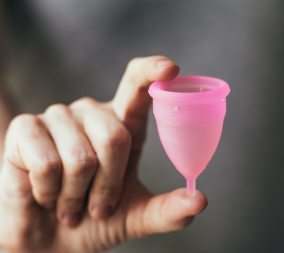A patient asked me last week if it is ok if she uses a Diva Cup (a brand of menstrual cup). I confidently said, “Sure, as long as it is working for you.” After the appointment I decided I better educate myself more, as while still not used with popular frequency, we are getting more and more questions in the office about menstrual cup use. So who better to tell you all about them than someone who has never used one and never will have a need to?!?! But like many topics in our blog series, I will do my best to research and describe some basics, pros, and cons of menstrual cups.
What exactly is a menstrual cup?
Menstrual cups are feminine hygiene products that are usually bell shaped and, when inserted into the vagina correctly, form an air-tight seal and collect menstrual blood. They are reusable (usually made of medical grade silicone) and long lasting (up to 10 years); thus, they are environmentally friendly. Afterall, think of all the tampons and pads one uses during their cycles. These cups cost in the $25 to $50 range and there are many many brands, the most mainstream probably are Diva Cups, Lena Cups, and Daisy Cups (to name a few). (So $25-$50 may last you 10 years!)
How do menstrual cups work?
The cups are inserted into the vagina and sit just below the cervix. When the correct size cup is inserted properly, a water-tight/air-tight seal is made between the open end of the cup and that walls of the vagina. The menstrual blood then collects into the cup. Because these menstrual cups can hold significantly more than a tampon or a pad, most women can keep them in up to 12 hours. This seems to be a big benefit to cup lovers as they like the freedom of not changing tampons and pads during the day and can generally get away with emptying the cup in the morning and then again in the evening in the privacy of their own home.
How do you pick the right cup for you?
There are different sizes geared for women of varying vaginal lengths and sizes, whether they have been pregnant before or had a vaginal birth before, etc. From the many articles I read and Youtube videos I watched, the consensus is that you may be forced to try more than one to get the right fit. This is unfortunate for some because of the cost. Here is a link to a quiz that helps with fitting a cup that will work for you. The cup users out there encourage patience in getting the right one… because once you do they swear by them.
How do you put it in and know it’s in correctly? How do you remove it without making a mess?
This is where Youtube can certainly help. It inserts similarly to a diaphragm, Nuvaring, or ring pessary if you have used those before. Basically, it is folded and inserted into the vagina far enough back that it can open up and form the seal. Sometimes this requires a twist or other adjustment to get it to properly pop open. Obviously, if not in correctly (of if you have the wrong size) you could experience leakage. Veteran cup users suggest using a panty liner the first several attempts as it is does take some time to get proper placement down pat. Removal also gets easier with practice. There is a stem on most of them to help pull it down a bit to make “breaking the air seal” of the ring easier before removing. There is some concern for women with IUDs in as far as pulling the IUD out with the cup. I suppose it is not impossible but it seems unlikely. According to WebMD there was a 2012 study that showed IUD dislodgment or removal no more likely with cup users than others.
Do menstrual cups smell?
Since blood in theory doesn’t come into contact with air, there should not be a bad odor. However, Google can tell you otherwise. It may take some time to get the best cleaning pattern, length of time inside, brand of cup, etc. for you to not experience an odor.
Can I have sex while a menstrual cup is inserted?
It seems to be an OK thing to have sex with a cup in as it should block the blood from your partner. I think this would honestly be a personal preference to the user… I’ll leave it at that!
What about infections?
With good hygiene and sterilization of your cup (instructions come with the cup on how to sterilize… but generally speaking they should be boiled after each menstrual cycle before storing them away) infection risk would be incredibly low. It certainly is not impossible if left in way too long to get an infection and even toxic shock… but that is exceedingly rare given the materials these are made of. I would give cups a very favorable safety rating at this time. I hope this information helps.
Maybe I have encouraged a few people to give this environmentally friendly, reusable, cost-effective menstrual solution a try.


















